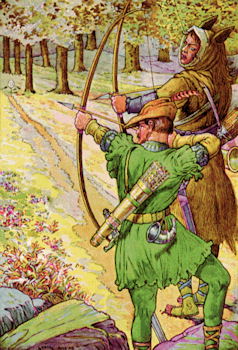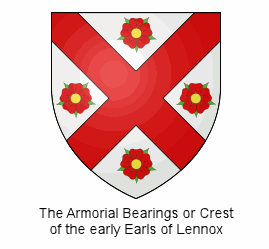Robin Hood of the Lennox
By Billy Scobie
 As a small boy, living in Dumbarton in the 1950s, long before I had seen a television, I was well familiar with Robin Hood and Sherwood Forest from the screen of our local cinema – La Scala. In my mind’s eye, in those days, I saw Robin and his merry men living out their adventures in the little strip of woodland at Dalmoak, which surrounded the Renton road, just a mile north of Dumbarton. Curiously, I was to discover, in recent years, that during the mediaeval period some land in that very location had been dedicated to the upkeep, in Dumbarton Parish Church, of the altar of Saint Sebastian – the Patron Saint of archers. Nothing more, of course, than one of those pleasing coincidences.
As a small boy, living in Dumbarton in the 1950s, long before I had seen a television, I was well familiar with Robin Hood and Sherwood Forest from the screen of our local cinema – La Scala. In my mind’s eye, in those days, I saw Robin and his merry men living out their adventures in the little strip of woodland at Dalmoak, which surrounded the Renton road, just a mile north of Dumbarton. Curiously, I was to discover, in recent years, that during the mediaeval period some land in that very location had been dedicated to the upkeep, in Dumbarton Parish Church, of the altar of Saint Sebastian – the Patron Saint of archers. Nothing more, of course, than one of those pleasing coincidences.
In May of the year 1547 the Governor of Dumbarton Castle granted the sum of forty-eight shillings to “certain minstrels of the town and their Robin Hood”. We may take it that this Robin Hood was a character who had a role in the traditional May Day rituals. Indeed, legal measures to outlaw the inclusion of Robin Hood in the May Day celebrations were unsuccessfully attempted some few years prior to the Reformation.
But these are mere footnotes. The fact is that we do not even know if the legendary Robin Hood was an actual historical person or an imaginary character. Numerous attempts have been made to identify him, or the person upon whom his legend was based – none conclusively. There have also been conflicting accounts as to his “real” geographical sphere of operation. Sherwood Forest has been, of course, his most famous hunting ground, but there are Robin Hood stories set in other locations.
In the Shakespearian era the writer Anthony Munday stated that the original Robin Hood had actually been the Earl of Huntingdon. This assertion, which became widely accepted, holds out fascinating possibilities…
The Register of Paisley tells us that when Alwyn, Earl of Lennox, died in 1155, the Lennox came into the keeping of the Earl of Huntingdon. This was because Alwyn’s children were still minors and the King of Scots warded this earldom to his own brother David, then Earl of Huntingdon. Not until 1199 did Alwyn, the second Earl of Lennox, finally succeed his father. For some forty-five years, therefore, the Earldom of Lennox was held by the Earl of Huntingdon. (see footnote)
 We know from McFarlane of McFarlane – antiquarian of the 18th century – quoted in “Memoirs of John Napier of Merchiston that “Alan (Alwyn) McArkill, second Earl of Levenax, having accompanied David, Earl of Huntingdon, King William the Lion’s brother, to the Holy Land, assumed upon his undertaking that expedition, as a badge, a red St. Andrew’s Cross in a white field, which, with the addition of four red roses, became the armorial bearings of his successors.”
We know from McFarlane of McFarlane – antiquarian of the 18th century – quoted in “Memoirs of John Napier of Merchiston that “Alan (Alwyn) McArkill, second Earl of Levenax, having accompanied David, Earl of Huntingdon, King William the Lion’s brother, to the Holy Land, assumed upon his undertaking that expedition, as a badge, a red St. Andrew’s Cross in a white field, which, with the addition of four red roses, became the armorial bearings of his successors.”
This David, who was Earl of Lennox as well as Earl of Huntingdon, would have been Prince David (1144-1219) the grandson of King David I of Scots.
David had a son, Robert, who is recorded as having “died young”… but we might know him as Robin Hood.
So, Robert of Huntingdon (born circa 1180) was the son of David Earl of Lennox. Significantly the tales of Robin Hood are generally set in the years around the turn of the 12th and 13th centuries, when Robert would have reached manhood.
The main centre of power of the earldom of Lennox was Dumbarton Castle, which had not yet become a royal possession. So. If Robert of Huntingdon, son of the Earl of Lennox, really became Robin Hood, it would not have been so unreasonable, after all, for some of his activities to have occurred within the earldom of Lennox – even close by Dumbarton.
Why then, or how, did the Robin Hood stories come to be based predominantly in England ? Well, in the first place it would not be the only time that a legend was dislocated from its true setting. For example, King Arthur, who was almost certainly based in Southern Scotland, was “acquired” by the English and recreated in Wales and Cornwall. Also, some of the very earliest references to Robin Hood appear in Scottish, rather than English, literature. Indeed, a quite plausible case has been argued for the Robin Hood character actually having been based on the Scots hero William Wallace !
I thought there is at least part of this tale on which this more light might be shed – the origins of the Armorial Bearings or crest of the Earls of Lennox. In Scotland all Coats of Arms, Heraldic Crests etc come under the control of the Lord Lyon, King of Arms. So I contacted him asking if there is some known story behind the choice of red saltire and roses on the heraldic device of the Earls of Lennox.
A prompt and full reply came from the Secretary to the Lyon Office, Court of the Lord Lyon. The substance of it was as follows:
“As you rightly say the Arms of Lennox of that Ilk, Chief of the Name and Arms of Lennox, are blazoned Argent, a saltire between four roses Gules, while the Duke of Richmond, Lennox and Gordon has in the second quarter of his Arms Argent, a saltire engrailed between four roses Gules.
The seal of Malcolm 5th Earl of Lennox, 1292, had a plain saltire between four roses so it would seem that the roses appeared at an early stage in the development of heraldry. A seal used by the 14th Earl of Lennox in 1578 had the saltire engrailed and from a quick look it would seem that the engrailed saltire continued to be borne by the Dukes of Lennox from that time.
Unfortunately the history of why most historic coats of arms have the charges they do is lost in the mists of time. However, for what it is worth, I find in Alexander Nisbet's 1722 work A System of Heraldry that he suggests that those who undertook expeditions to the Holy Land for the most part were crossed with the form of crosses used by their own country so that many families in Scotland carry saltires. He added that Sir James Balfour, in his manuscript account of the nobility of Scotland, states that Malcolm de Lennox, one of the progenitors of the Earls of Lennox, went to the Holy Land and was crossed.
I do hope this is of some help to you but please bear in mind that much of the early history of the development of heraldry as we know it is sketchy and my comments above should be treated cautiously.”
That reply told me a few things that I didn’t know. One was that at least two of the early Earls of Lennox went on the Crusades. The Crusades are not often thought of as having involved Scotland very much, but if these Earls of Lennox went on Crusades then it seems very likely that local men of the Lennox must have accompanied him.
The other is that early family heraldic achievements which have crosses on them – in Scotland it will be saltires of whatever colour – almost certainly mean that the head of the family went on a Crusade. So we have a short-hand method of identifying which other families and their followers were Crusaders. Based on these heraldic achievements, it’ll be interesting to see how widespread across Scotland going on a Crusade was.


